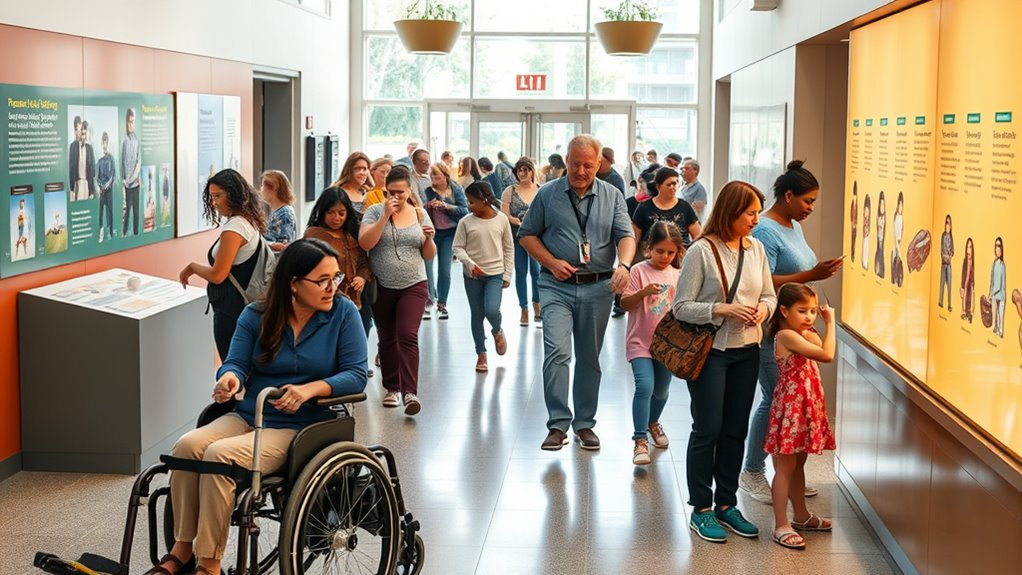To guarantee inclusivity and accessibility for all patrons, design your space with sensory-friendly environments, such as calming colors, soft lighting, and quiet zones. Incorporate assistive technology like hearing loops, visual aids, and physical modifications like ramps. Staff training fosters understanding and patience, making everyone feel welcome. Regularly gather feedback to improve. By making these thoughtful adjustments, you create a space where everyone can participate comfortably—exploring further will reveal even more effective strategies.
Key Takeaways
- Design spaces with calming colors, soft lighting, and quiet zones to reduce sensory overload for diverse patrons.
- Incorporate assistive technology like hearing loops, visual aids, and communication devices to support different needs.
- Ensure physical accessibility through ramps, automatic doors, and accessible restrooms for all visitors.
- Train staff to understand diverse needs, promote patience, and provide proper assistance and support.
- Regularly gather visitor feedback and update sensory-friendly features and technology to enhance inclusivity.

Have you ever wondered how we can create spaces that everyone can truly access and enjoy? Making environments inclusive starts with understanding that each person’s needs are unique. One effective way to do this is by designing sensory friendly environments. These are spaces carefully curated to reduce sensory overload, which can be overwhelming for individuals with sensory processing differences, such as those with autism or other sensory sensitivities. To achieve this, you might incorporate soft lighting, calming colors, and quiet zones. Removing loud noises and sudden sounds helps create a more welcoming atmosphere. Comfortable seating and calming textures can also make a significant difference. By paying attention to these details, you create a space where everyone feels safe and comfortable, encouraging participation and engagement.
Design sensory-friendly spaces with calming colors, soft lighting, and quiet zones to foster comfort and inclusion for all.
Another vital element in ensuring accessibility is assistive technology integration. This involves incorporating tools and devices that help bridge gaps in communication, mobility, or sensory input. For example, you could install hearing loops or provide assistive listening devices to support those with hearing impairments. Visual aids, such as large print signage or digital screens with adjustable text size, help individuals with visual impairments navigate spaces with ease. For people with mobility challenges, ramps, automatic doors, and accessible restrooms are essential. Assistive technology isn’t just about physical accommodations; it also includes software and apps that facilitate communication, such as speech-to-text programs or picture exchange communication systems. When you integrate these technologies seamlessly into your space, you remove barriers, making it easier for everyone to participate fully. Additionally, leveraging emerging AI-driven security systems can help monitor and adapt to diverse needs, ensuring a safer environment for all users.
Creating an inclusive environment also involves ongoing education and awareness. Encourage staff and volunteers to learn about different needs and how to support diverse patrons effectively. Training ensures they understand how to operate assistive devices properly and recognize signs of discomfort or confusion. Promoting a culture of acceptance and patience helps foster an atmosphere where everyone feels valued. Remember, accessibility isn’t a one-time fix but an evolving process. Regularly seek feedback from your visitors to identify areas for improvement. Simple adjustments, like adding more sensory-friendly areas or updating technology, can greatly enhance the experience for your patrons.
Ultimately, designing with inclusivity in mind shows that you genuinely care about making your space accessible to all. By combining sensory friendly environments with assistive technology integration, you create a welcoming, adaptable, and empowering setting. When everyone feels considered and supported, your space transforms into a place where all patrons can explore, learn, and enjoy without barriers. This commitment not only enriches lives but also demonstrates that inclusivity is at the heart of community and connection.
Frequently Asked Questions
How Can Technology Improve Accessibility for Diverse Patrons?
Technology improves accessibility for diverse patrons by utilizing assistive technologies like screen readers, magnifiers, and subtitles, making content more reachable. You can promote digital inclusion by offering easy-to-navigate websites and mobile apps that cater to different needs. By integrating these tools, you guarantee everyone can participate fully, regardless of their abilities. Embracing innovative tech helps create an inclusive environment where all patrons feel welcomed and valued.
What Training Do Staff Need to Serve All Visitors Effectively?
You need to train staff in cultural sensitivity and conflict resolution to serve all visitors effectively. This helps them understand diverse backgrounds and address issues promptly and respectfully. Focus on active listening, empathy, and recognizing biases. Regular workshops and role-playing scenarios can reinforce these skills. When staff are well-trained, they create a welcoming environment, ensuring every patron feels valued and respected, regardless of their background or needs.
How Do We Measure the Success of Inclusivity Initiatives?
You measure the success of inclusivity initiatives by tracking audience engagement and analyzing diversity metrics. Observe if more diverse visitors participate in programs and feel welcomed. Collect feedback through surveys focusing on accessibility and inclusivity. Comparing before-and-after data helps identify improvements. Regularly reviewing these metrics guarantees your efforts genuinely foster an inclusive environment, allowing you to adjust strategies to better serve all patrons and promote ongoing engagement.
What Are Cost-Effective Strategies for Implementing Accessibility Features?
Think of your efforts like a vintage radio; with the right tuning, you get clear sound without breaking the bank. To implement affordable accessibility features, explore funding opportunities like grants and community partnerships. Use cost-effective solutions like portable ramps, adjustable signage, or free digital tools. Prioritize high-impact areas first, and consider volunteers or donations to stretch your budget. These strategies help you maximize inclusivity without hefty expenses.
How Can Feedback From Marginalized Groups Be Integrated Into Planning?
You can integrate feedback from marginalized groups by actively engaging them through community involvement initiatives. Organize focus groups or surveys to gather their insights, and guarantee their voices influence policy development. By fostering open dialogue and building trust, you make them feel valued. Incorporate their suggestions into your planning processes, and regularly revisit policies to adapt to evolving needs, creating a more inclusive environment for everyone.
Conclusion
Think of your space as a garden, where every plant, no matter its shape or size, deserves sunlight and care. When you prioritize inclusivity and accessibility, you’re planting seeds of kindness that flourish into a vibrant, welcoming landscape. By opening your doors to all, you create a garden where everyone can grow, thrive, and feel truly at home. Keep tending to this garden, and watch your community blossom into a beautiful, diverse paradise.









